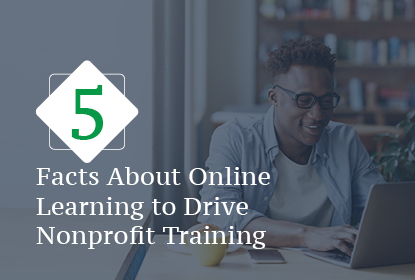If 2020 (and the beginning of 2021) has shown nonprofits anything, it’s that online engagement is real and it’s not going away anytime soon. This trend has affected your donor relations and online fundraising, but also your internal operations, such as educating and training staff and volunteers.

At Nonprofit.Courses, we’re dedicated to providing charitable organizations with free and affordable training resources on a wide variety of topics. But before you get started, here are five facts you should know about online learning:
1. Online learning has become the new normal.
There was a time not very long ago when online learning wasn’t very common. Skeptics would say things like “I learn best in a classroom.” But how would they know? They never experienced online learning. Yet abandoning methods that went back thousands of years to Aristotle and beyond just didn’t seem right.
Today, that’s changed—a lot. But the pandemic wasn’t the only cause. In a remarkably prescient headline in late 2017, SmallBiz Trends stated that “98% of All Companies Plan to Use E-Learning by 2020.”
Pandemic-induced social distancing simply accelerated what was already a growing trend: an increasingly online world. Millions learned that their cell phone, tablet, and computer’s camera were useful for more than social media posts. Traditional seminar speakers suddenly found that they could become “content creators,” and that it wasn’t too difficult to produce high-quality, valuable webinars after all.
Normalizing online learning has and will continue to be a major assistance to nonprofits. To start, it significantly cuts the cost of training staff and volunteers. Just the transportation savings alone will make a big difference in their mission service budgets.
Perhaps even more important is the flexibility it offers. Nonprofit staff are some of the most time-stressed people you’ll meet. Being able to keep up on the latest trends in their mission and understand how to secure funding at just about any time of day makes a big difference.
Oh, and let’s not forget volunteers. Training volunteers, from the board member to the greeter, comes with its own host of concerns. Scheduling was just the first of many obstacles—but not anymore. On-demand training resources mean they can learn about their responsibilities anytime, anywhere.
2. Employees spend their time online anyway.
In any generation, young people tend to be the early adopters of new technology and trends. Online education is no different. Inside HigherEd reported that in the fall of 2018, 33.1% of college students took at least one online course. In our post-pandemic world, we can reasonably assume that this number is nearly 100%, as almost every university went online for a major portion of their curriculum.
But this trend isn’t exclusive to the 18- to 22-year-old cohort. According to this 2017 Online Education Trends Report, 68% of online learners were experienced professionals and 36% consider themselves to be “industry switchers.” We should expect this to be even more true today.
But why is this important to nonprofits?
Nonprofits tend to hire people who are new to the workforce, as well as those who are switching to more meaningful, mission-driven careers. These workers are already used to, and many times prefer to turn to their phone, tablet, or computer for educational experiences.
Given the advantages of online learning to the learners and their employers, this is very good news.
3. Humans retain more information through microlearning.
Like any new technology, online learning can take a while to learn how it works best. Take early television for example. If you look to the first TV shows in the 1950s, you’ll see comedians like Milton Berle and Jack Benny doing exactly what they did on stage in front of a live audience, or for their radio shows, now in front of a (huge) camera. That was a great start, but it took a bit to figure out that TV could do much, much more.
It’s still early for online learning, but what’s become clear is that microlearning tends to be the way to go. This powerful e-learning strategy takes advantage of the human brain’s tendency to absorb information best in small, bite-sized bits.
This is exactly the opposite of our traditional learning methods which would leave a learner seated without a break for an hour or more at a time.
To get a good mental image, think of access to the brain as a funnel. If you pour too much water into the funnel, a lot spills out and never makes it in the bottle. You need to pour deliberately in small amounts and pause occasionally for the funnel to process the water before you add more.
It’s the same way with your brain. Too much, too fast and it spills away never to be recovered. Microlearning addresses that with short, focused learning; pausing in between for processing.
What’s even better is that learners prefer it. In his article “Top LMS Features To Drive Employee Engagement” Brian Westfall cited that 58% of respondents stated that they’d be more likely to use a learning management system if it incorporated multiple shorter, five- to seven-minute lessons as opposed to a few hour-long sessions.
This is great for nonprofit staff. Yes, again for the overscheduled staff member or volunteer, but also because you can vary the content quickly. Small staff sizes mean that one person wears a lot of hats. It’s a great advantage to get quick training on a wide range of topics in a short time.
4. Online training increases worker retention.
Many studies cite online education as a positive factor in staff retention. In her doctoral thesis, Why Stay? A Qualitative Study on Retention and Attrition of Employees in a Retail Environment, Theresa Sands-Dawling cites the advantages of online learning in keeping workers in what is traditionally a high-turnover environment.
Shristi Shah, Oliver Ross, and Stephen Pickering in their Distance-Learning Initiatives Targeting Non-physician Anesthesia Providers in Low-Resource Environments cite no less an authority as the World Health Organization for the same conclusion when they say that “The WHO recommends targeted accessible continuing education as a key to support rural health worker retention.”
While employee retention is an important issue across every type of business and organization, it tends to be even more significant in the nonprofit sector. In fact, Forbes points out that “Employee turnover has long been an issue for the nonprofit sector… The voluntary annual turnover rate is 19%—far outpacing the all-industry average of 12%.”
While not a panacea, online professional development could play a significant role in reducing turnover among nonprofit employees, thus saving money and boosting morale, leading to more efficient and greater focused mission delivery.
5. Online education opportunities close skill gaps.
There’s a saying that goes, “what takes three jobs in government or two jobs in business is one job in a nonprofit.”
That’s because nonprofits are highly lean, budget- and personnel-stressed organizations, which leads to workers and volunteers regularly wear “multiple hats.” However, this can cause what human resources professionals refer to as“skill gaps;” or the difference between what someone is responsible for and what they have the training to accomplish.
In their 2019/2020 Global Skills Gap Report, online course provider Udemy reported that more than 83% of employees worldwide believe there is a skills gap, and 62% of employees feel personally affected by it.
In their February 2020 article, “Beyond hiring: How companies are reskilling to address talent gaps,” management consultant McKinsey & Company tells us that “Because organizations may need to cultivate a broad range of workforce skills, they will likely need to assemble learning resources from multiple providers—for example, online platforms, universities, and technical organizations.”
Clearly, online education can make a major dent in skill gaps for all sorts of employers, and especially nonprofits.
You really don’t need statistics or studies to convince you that online professional development will become a major asset to any nonprofit’s staff and volunteer’s skill development. The convenience, cost, and time savings alone should show you that. But clearly, there are a lot more advantages than those, and probably dozens more we will only discover as it continues to be used more and more. Good luck!



COMMENTS